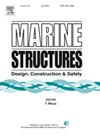Behaviour of vertically loaded spudcan foundations under sustained uplift
IF 5.1
2区 工程技术
Q1 ENGINEERING, CIVIL
引用次数: 0
Abstract
Extracting a spudcan foundation in clay is frequently challenging and time-consuming due to the substantial pull-out force needed to overcome the soil breakout resistance. The actual mode of spudcan extraction in the field is that the spudcan is extracted under a constant force provided by the buoyancy of the hull rather than the undrained displacement uplift. This paper investigates the behaviour of the vertically loaded spudcan foundations under sustained uplift through centrifuge experiments and coupled pore fluid-effective stress large deformation finite element simulations. The finding indicates that the threshold sustained load of spudcan failure is approximately 60% of the undrained breakout resistance. When the sustained load is higher than this threshold, the uplift displacement of the spudcan is similar to the soil creep curve, characterised as accelerating at the beginning, then entering a stable stage, and finally tending to accelerate uplift until the spudcan pull-out failure. The failure mechanisms under different uplift modes are also revealed. Under sustained loading, the soil disturbance area increases with the sustained load, gradually manifesting local circulation around the spudcan. Total stress and pore pressure responses lie in the sustained consolidation status under various levels of sustained force.
持续隆升作用下垂直荷载下铲式地基的性能
由于需要巨大的拔出力来克服土壤破裂阻力,在粘土中提取铲式地基通常是具有挑战性和耗时的。现场实际的排污方式是在船体浮力提供的恒力下进行排污,而不是在不排水的位移隆起作用下进行排污。通过离心试验和孔隙-有效应力-大变形耦合有限元模拟,研究了持续隆升作用下垂直载荷下铲式地基的受力特性。研究结果表明,劈裂管失效的阈值持续载荷约为不排水破裂阻力的60%。当持续荷载高于该阈值时,铲斗的上拔位移与土体蠕变曲线相似,表现为开始加速,然后进入稳定阶段,最后趋于加速上拔,直至铲斗拔出破坏。揭示了不同隆升模式下的破坏机制。在持续荷载作用下,土体扰动面积随着持续荷载的增大而增大,并逐渐表现为桩周局部环流。在不同持续力水平下,总应力和孔压响应均处于持续固结状态。
本文章由计算机程序翻译,如有差异,请以英文原文为准。
求助全文
约1分钟内获得全文
求助全文
来源期刊

Marine Structures
工程技术-工程:海洋
CiteScore
8.70
自引率
7.70%
发文量
157
审稿时长
6.4 months
期刊介绍:
This journal aims to provide a medium for presentation and discussion of the latest developments in research, design, fabrication and in-service experience relating to marine structures, i.e., all structures of steel, concrete, light alloy or composite construction having an interface with the sea, including ships, fixed and mobile offshore platforms, submarine and submersibles, pipelines, subsea systems for shallow and deep ocean operations and coastal structures such as piers.
 求助内容:
求助内容: 应助结果提醒方式:
应助结果提醒方式:


